An Arturia emulation of the classic Roland TB-303 was all but inevitable. But with plenty of bassline plug-ins out there, can this one bring something new to the table? Let’s get our hands on the new Arturia Acid V.
Acid, plus
Arturia’s soft synth collection includes some exceptional and rarely-emulated instruments. But with Acid V, they’re moving into pretty crowded waters, as a hardware and software recreations of the Roland original abound. The Acid V looks like a 303, and covers all the basics with their usual oversized skeuomorphic look. (The interface is scalable; don’t worry.)
So let’s start with what’s on the Acid V that isn’t on an original TB-303:
- Vibrato (including per-step sequence control)
- Sub oscillator (with rect, saw, and sine waves and octave control, and the ability to pair with bass boost)
- Voice settings for tweaking parameters, akin to 303 hardware mods (filter cutoff range, pulse width, etc.)
- Advanced 64-step sequencer/arp with scale constrain feature (and yes, you can define custom scales)
- Randomization for generating new patterns
- 3 modulators, routable to nearly everything (only the voice settings are missing – you can even route modulation to sequencer rate)
- 4 effects slots
There are also some nice extras like the ability to map the hold to a sustain pedal.
The Acid V sounds really good, and you can tweak it in a way that makes it sound like original 303 hardware – or even what you imagine sounds more like the original hardware – with voice settings. I doubt seriously you’d choose this one for authenticity alone, though, given the competition from Roland Cloud, Audiorealism, and D16, among others. So let’s instead assume that what’s appealing about Arturia’s take is the ability to expand on what a 303 is and add in other ideas.
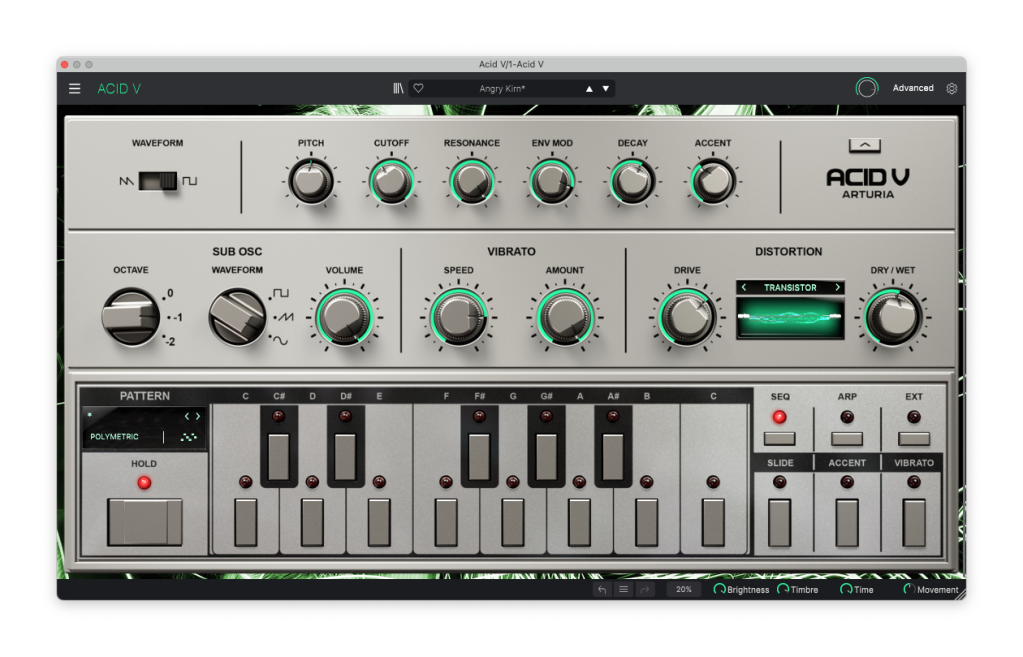
Sound designers’ tour
If you just want a strong 303 emulation, some more out-there acid-y extras, and a bunch of preset patterns and sounds, Arturia of course has you covered. But let’s look what’s going on on the interface.
The main UI gives you all the basic 303 controls – pitch, cutoff, resonance, env mod, decay, accent, and the waveform switch, plus a row of trigger-able buttons and HOLD. You can’t program 303-style on the Acid V – there’s only the modern sequencer option – so you’ll use those buttons mainly for transposition and simple triggering.
Workflow hands-on: it’s quick.
You’ll also see some immediate additions. The SUB OSC is a big deal, especially as you can push its level up with the BASS BOOST voice setting. VIBRATO is basically a fixed LFO that can be extended from slow pitch drift all the way up to audio-rate, FM-style modulation. It’s enabled per-step in the sequence, which is great for variations, though it doesn’t retrigger – so if you toggle a series of adjacent steps, it’ll continue to modulate uninterrupted.
DISTORTION gives you a ton of options, as you’d expect, including tape, tube, transistor, diode, crunch, overdrive, something called “thick,” and other models. (And yes, Germanium. Anyone playing the Arturia drinking game, take a shot.) These nicely vary from very subtle to very intense – I’m especially fond of that raunchy transistor. There’s greater diversity than in some competing products, and it’s convenient to be able to dial these in exactly and save them with a patch.
Honestly, if a single section made me wish Arturia made this instrument as hardware, it’d be the distortion section.
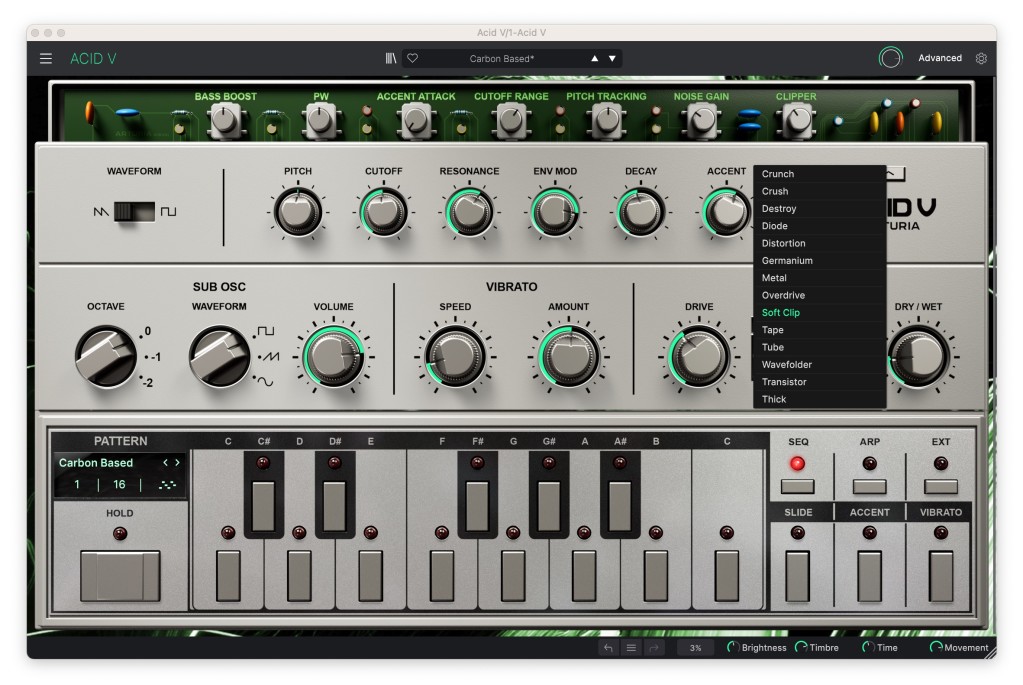
Voice settings
Click the up arrow above ACID V, and you get a range of Voice Settings that correspond to common hardware hacks of the original TB-303 – like the best-in-class Devilfish mods. That includes a pulse width control, which makes the rectangle oscillator a lot more interesting, and an extended cutoff range (since Roland engineers limited the upper-end cutoff on the original device). The Clipper is my favorite, setting a value for internal clipping and allowing some really edgy variations of sounds. Pitch Tracking sets accuracy and Noise Gain adds, uh, noise; those two can be dialed in for special effects or to emulate aging hardware. Accent Attack is actually a bit too subtle to hear most of the time but softens the attack parameter. Bass Boost pushes the level of the SUB OSC so the combination of those two is terrific for thickening sound.
Advanced mode and modulation
You know the drill: Arturia’s effects and instruments really get interesting once you click the “advanced” button, which you should do even if you aren’t advanced. (Hey, you can’t break anything!)
The three modulators are really the star of the show – and the argument for why the Acid V needs to exist. You’ve seen these modulation tools on other Arturia instruments, but the funny thing is, they’re doubly inspiring on a one-oscillator instrument with an acid sequencer. It’s just a natural for “let’s f*** with this a little” modulation – again, even if you don’t think you know what you’re doing. Go for it. I mean, the thing is called “acid,” right?
Each modulator comes with generative/drawing tools, looping and retriggering options, and a bunch of clever preset shapes. They run both synced and free-run. And you can drag and drop to nearly everything with a continuously variable parameter – the only exception I could find is the Voice Settings.
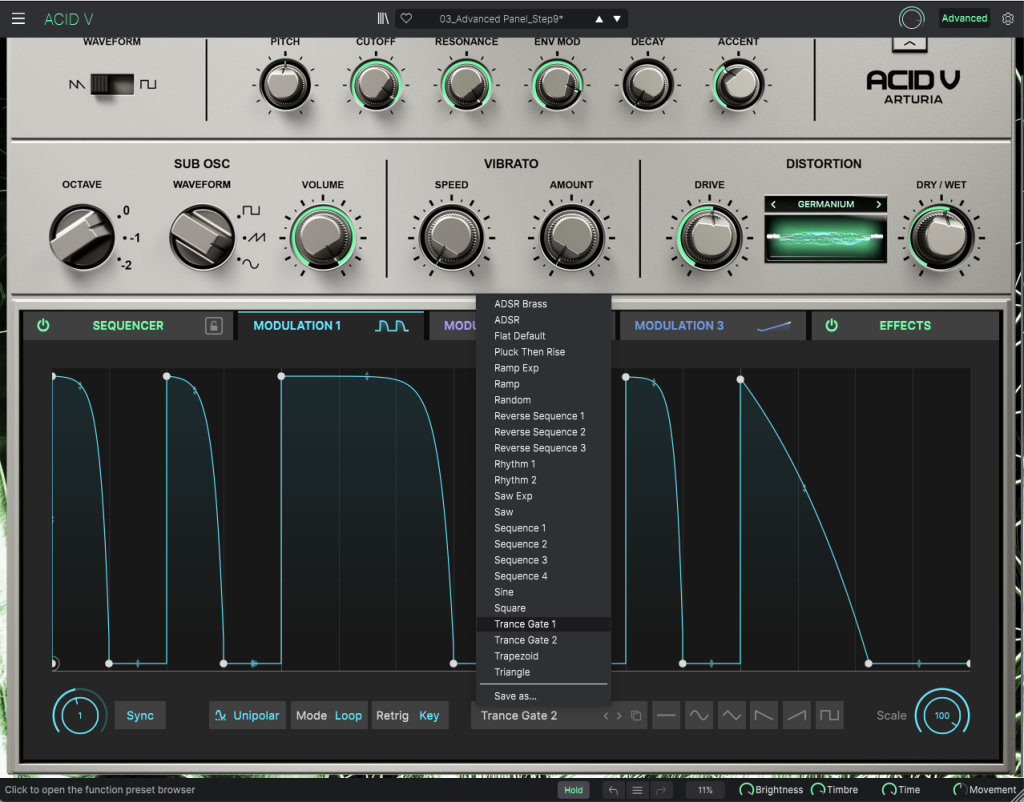
The three modulators are really the star of the show – and the argument for why the Acid V needs to exist.
You can even modulate the sequencer parameters – that is, gate and even rate. By modulating rate with different shapes, you can get a bunch of interesting irregular patterns, which is way more than I expected out of a 303 recreation.
Sequencer
Arturia has packed a reasonably powerful 64-step sequencer into this plug-in. All 64 steps are available, and you’ll definitely be in acid territory as there’s no direct triggering of different patterns, which feels like a bit of an omission. (Roland’s TB-03 / Roland Cloud TB-303 has some simple pattern triggering which would have been a natural here!)
But where this thing is really fun is the aforementioned modulation capability for rate and gate, plus polymetric mode. Click this on, and you get separate sliders to adjust the pattern length independently for octave, pitch, slide, accent, and vibrato.
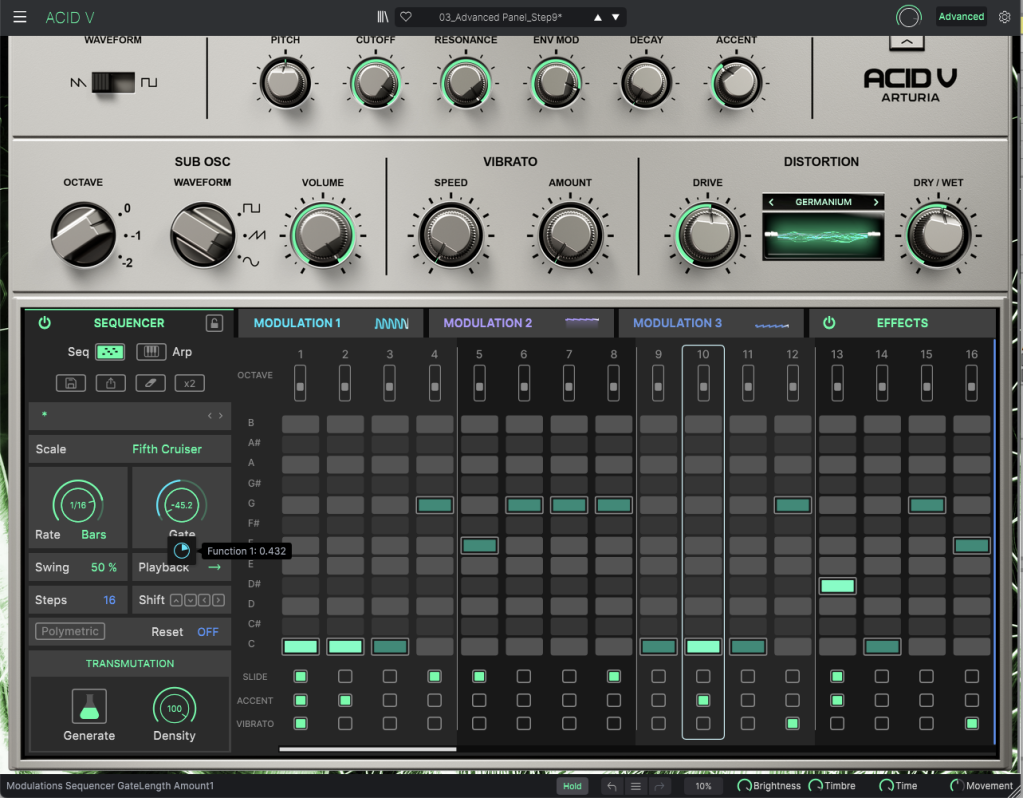
The polymetric mode is just insanely fun, capable of producing a lot of unique patterns that go beyond the usual endless-repeat acid mode. (Nothing against that, but unless you’re DJ Pierre, it could be time to try something new!)
And I think this puts the plug-in in a class with some of the better hardware recreations of the 303, as well (specifically, the Cyclone Analogic TT-303, which probably would be my desert island 303 hardware just for its sequencer).
The polymetric mode is just insanely fun.
Effects
The Effects section is also strong. You get four fixed effects slots, with a bunch of options for how to fill them, including some minimalistic graphic representations and lots of parameter controls, and yes – again, everything can be modulated.
Effects choices:
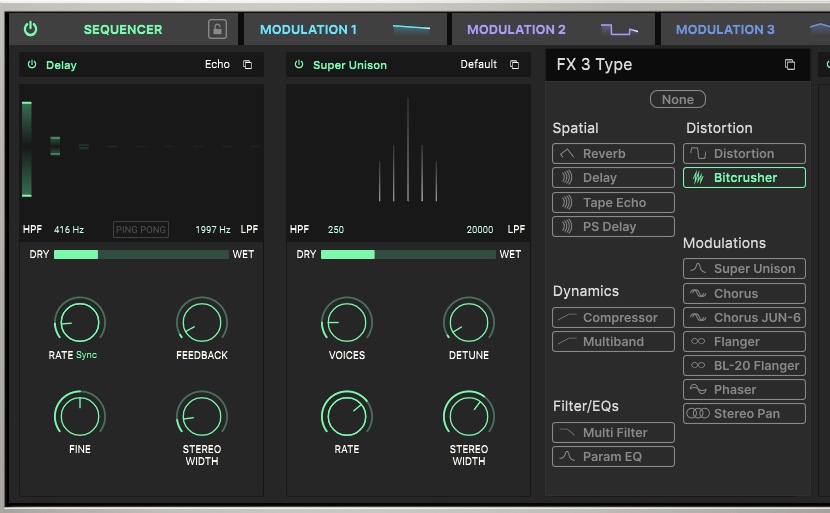
Spatial (I.e., delay-based)
- Reverb
- Delay
- Tape Echo
- PS Delay (a pitch shifting delay – definitely my favorite)
Dynamics
- Compressor
- Multiband compressor
Filter/EQs
- Multi Filter (LP / HP / BP and two comb options, plus slope)
- Param EQ
Distortion
- Distortion – again, with all the various shapes possible, including waveshapers, wavefolding, clipping, hardware emulation, and yes – Germanium! Crucially, that has a built-in highpass filter.
- Bitcrusher
Modulations
- Super Unison (this one is well worth messing with)
- Chorus
- JUNO-60-style Chorus (erm, “JUN-6”)
- Flanger
- BL-20 Flanger (add that one to the Arturia drinking game, too)
- Phaser
- Stereo Pan
The competition
So this would all be must-buy territory – if ACID V were in a vacuum. It doesn’t, though, and odds are fairly good you’ve already got a decent 303 on your system. Both Audiorealism’s offering (as the name implies) and Roland’s own emulation on Roland Cloud do really well. Then again, with the right tweaks, so, too, do D16 and Arturia.
As a synth engine alone, Audiorealism and Martin Janney’s wonderfully obsessive approach are standouts – and you may well have your own sequencer and effects you want to use. D16’s second version added a whole bunch of new parameter edits that go beyond even the DevilFish-style options from Arturia. For a sampled version, Puremagnetik has the TeeBee – for just $15 – though some behaviors (like slide) are better modeled than sampled.
This is about expanding on the acid idea, though, I think. And then the most direct competitor is that D16 Phoscyon2. On paper, the feature list for Arturia’s offering almost reads like D16’s. Vibrato? Check. Multiple distortion modes? Check. Arp/sequencer, and a 64-step sequencer with lanes for randomization and separate sequencer lanes for slide, accent, and vibrato? Check. Insert effects with reorderable routing? Check. Drag and drop pattern export? Check. That sequencer interface is pretty similar, and you even have a skeuomorphic interface for parameters.
If you already own the D16, I can’t imagine you’ll have any interest in Acid V. But let’s compare for the sake of which you’d likely choose – especially as Phoscyon2 is part of D16’s summer sale right now.
In practice, the differences get a little interesting.
First, vibrato is one of the most compelling features of Arturia’s offering and it’s a completely different approach than what D16 employed. Arturia uses an LFO; D16 uses two alternating notes with note duration for speed and spread for range. The fact that they share a name is basically a misnomer. I’m going to give Arturia the edge in this one.
There’s no equivalent to Arturia’s deep modulation in any 303 model I’ve seen, so that’s a total win for ACID V.
But D16 has some really beautiful parameter additions on their 303 that Arturia lacks, and that sound is something special.
But the effects in D16’s outing are also comparatively vanilla, so even though I miss the drag-and-drop reordering in ACID V, Arturia is the clear winner here. That’s just a deep library of effects, and for 303 presets where you’re dialing in nuanced combinations, it’s great having them built into the plug-in.
The sequencer comparison is more nuanced than it looks. These two sequencers (and their arpeggiator modes) look the same on the surface. But I love D16’s per-parameter randomization, rather than the global-only randomization (with amount) on the Arturia. (Audiorealism does per-parameter randomization, too.) Live override is also a stroke of brilliance. Wait – correction. So in fact, ACID V can do per-parameter generative values. If you hover next to each lane, you get a continuously adjustable value for each lane – 1.0 maxes out parameters, 0.0 zeroes them, 0.5 randomizes them (and variations). (Thanks, Cyril!)
I give the edge to the ACID V’s sequencer, because having per-lane polymetric mode and the ability to freely modulate gate and rate with any modulation shape you desire is unlike anything I’ve seen in a 303 plug-in. Now doubly so that I’ve been directed to per-lane randomization!
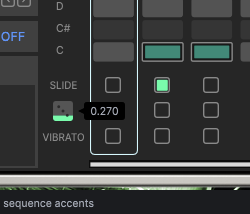
And there are live overrides, too. Those triggers are on the main panel. Your best bet here is likely to MIDI map these for live playing.
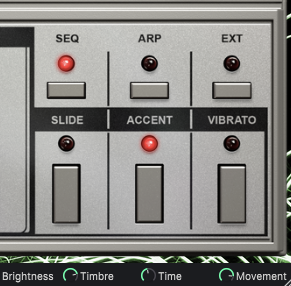
One point to D16 for the ability to drag to reorder effects – with Arturia, you have fixed effects slots and a dropdown, so you have to manually swap out effects in order to change the routing. (Note that when you do this, you also lose parameter values, so it’s useful to save presets for any settings you particularly like.)
Some differences are down to taste. There’s some overlap in distortion models between D16 and Arturia; D16 has some great vintage 303 distortion algorithms (including the RAT), while Arturia has more variety. (See also D16’s awesome Devastator 2 and Arturia’s deep ColdFire standalone distortion effects, both of which I love! I mean, sure, you can put two distortions in the plug-in and then add another distortion plug-in because why not?)
In practice, the Acid V feels and sounds different than D16’s offering. Having a sub oscillator is huge – and despite the documentation telling you you should try sine wave at -1 octave, I found a lot of the different combinations satisfying. Arturia’s effects are also really rich, and include critical filter options for fine-tuning delays and whatnot.
Honestly, if this section is long and rambling, it’s because you can’t go wrong with almost any of these plug-ins. I’d easily recommend these two, and I think because of their expanded feature sets I’d choose these two over the other excellent options.
Conclusions
This is honestly a big surprise for me personally. The last thing I thought I’d want is another 303 – let alone one that on first glance appears to get into some territory that’s been covered elsewhere. But Arturia’s combination of the 303 with its in-house modulation, effects, and distortion – plus that polymetric sequencer – make for an instant inspiration machine. If you do covet acid, it’ll give it to you. If you want to do something acid-y but different, it’s just as adept at that. And if you want a unique acid-derived tool to make something that sounds completely unlike acid, it’s capable of that, too.
Oh, and another thing – whereas I quickly bored of having just a plain vanilla 303, something like this with lots of effects and modulation and an interesting sequencer is far more likely to stick.
I would love features like reorderable effects and improved microtuning behavior across the Arturia range, but those are relatively smaller niggles – especially for an acid plug-in.
And this is important, as I got this a little wrong in the first draft of this review – this is the best 303 sequencer I’ve seen yet. Polymetric support plus per-lane randomization is fantastic.
If you’ve already got a 303 you’re happy with, you can probably skip this. (Roland’s own emulation is bare-bones, but authentic – and if you’ve got a Roland Cloud subscription, you own it already.)
But if you were looking to add some acid to your rig, this should be high on your list. It’s just one of those rare instruments that is immediately fun to play with, that can make you feel something even at those times when your energy and inspiration are sapped. And that’s a good way to follow up on the 303’s legacy.
Acid V is available now with an intro discount (plus an offer for V Collection owners). There’s also a free demo.
Here are some sounds from my explorations (more details):
Acid V how-to
Arturia has some nice tutorials here, too … uh, “ambient acid”?:
If you buy something from a CDM link, we may earn a commission.
Acid V is available from Plugin Boutique with sale pricing:
plus other Arturia software:
While we’re at it, so is D16’s offering, also on summer sale: